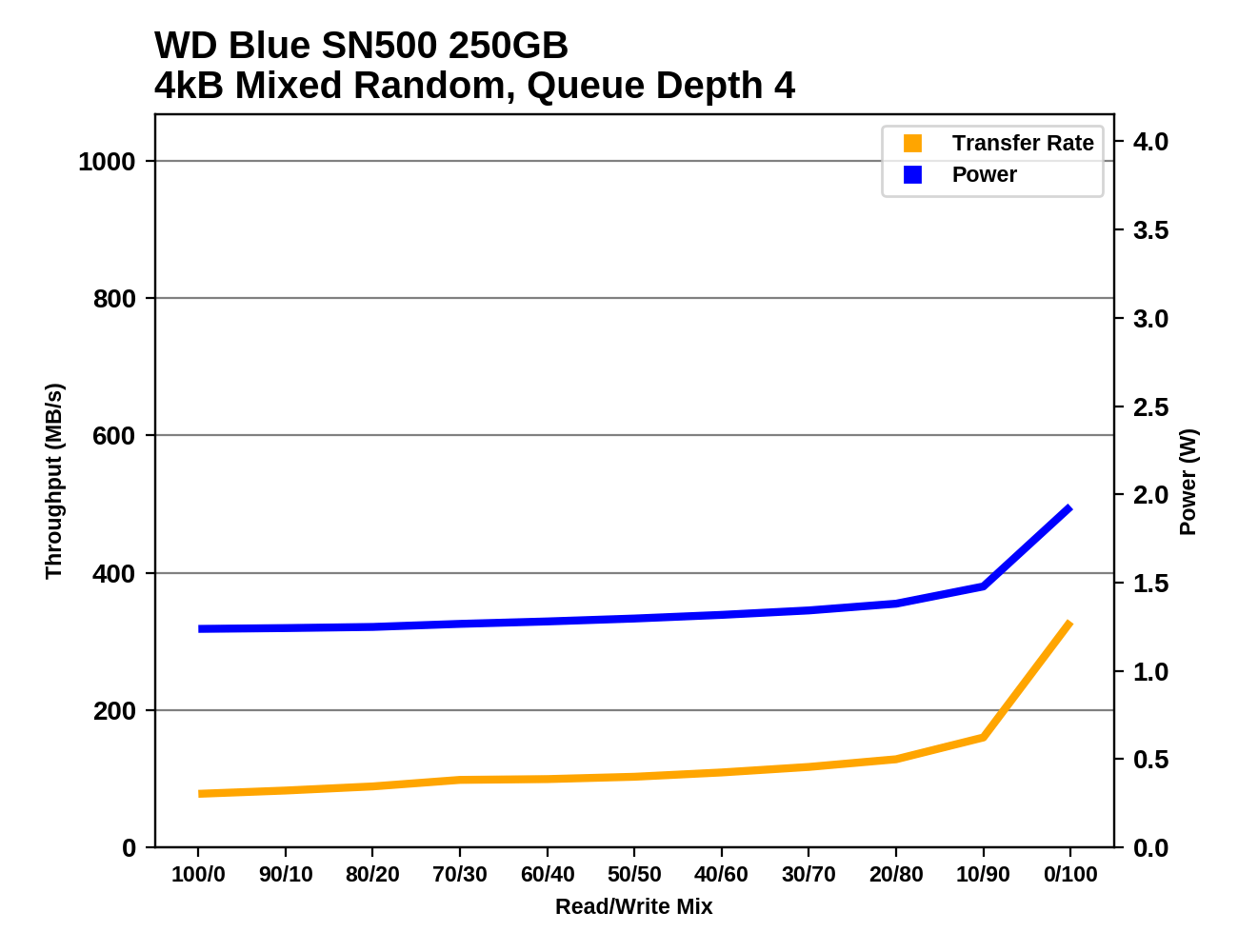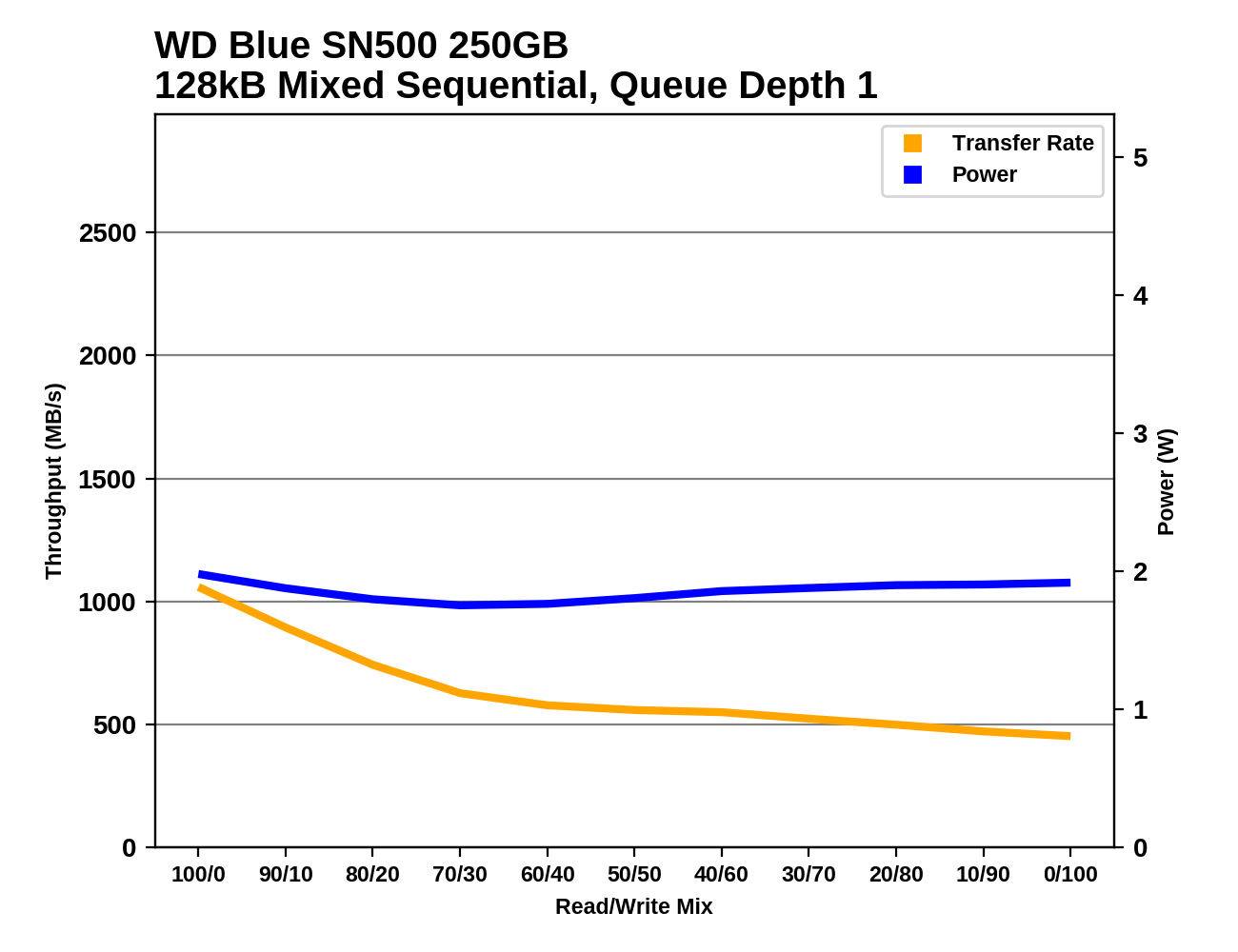The Western Digital WD Blue SN500 SSD Review: Moving The Mainstream To NVMe
by Billy Tallis on April 19, 2019 9:30 AM ESTMixed Random Performance
Our test of mixed random reads and writes covers mixes varying from pure reads to pure writes at 10% increments. Each mix is tested for up to 1 minute or 32GB of data transferred. The test is conducted with a queue depth of 4, and is limited to a 64GB span of the drive. In between each mix, the drive is given idle time of up to one minute so that the overall duty cycle is 50%.

The WD Blue SN500 is very slightly slower on the mixed 4kB random IO test than the larger WD Blue SATA SSD, and is significantly slower than the various high-end NVMe models. The other two entry-level NVMe drives are even slower than the SN500.
 |
|||||||||
| Power Efficiency in MB/s/W | Average Power in W | ||||||||
Despite relatively low performance, the WD Blue SN500's efficiency score on the mixed random IO test is a bit above average due to it drawing far less power than most of the high-end NVMe SSDs or even the SATA drives that outperformed it.
 |
|||||||||
The WD Blue SN500's performance on the mixed random IO test shows a fairly normal slow growth in performance as the workload shifts to be more write-heavy. At the very end, the ability to combine writes without any read operations getting in the way leads to a jump in performance even though the SLC write cache is full during almost all of this test.
Mixed Sequential Performance
Our test of mixed sequential reads and writes differs from the mixed random I/O test by performing 128kB sequential accesses rather than 4kB accesses at random locations, and the sequential test is conducted at queue depth 1. The range of mixes tested is the same, and the timing and limits on data transfers are also the same as above.

The WD Blue SN500 cannot compete with most of the high-end NVMe SSDs on the mixed sequential IO performance test, but it offers decent overall performance that is a bit higher than some of the other low-end NVMe drives and is a clear step up from any of the SATA drives.
 |
|||||||||
| Power Efficiency in MB/s/W | Average Power in W | ||||||||
The power efficiency of the SN500 on this test is quite a bit lower than what the 1TB WD Black SN750 delivered, but among other 256GB-class drives the SN500's efficiency is top-tier.
 |
|||||||||
As writes are added to the workload, the WD Blue SN500's performance drops—quickly at first, but then almost leveling out as the drive approaches SATA speeds. By the end of the test when the workload is pure writes, the SN500 is performing below theoretical SATA limits, but beats any actual 256GB-class SATA drive we have on hand.










50 Comments
View All Comments
rkmcquillen - Sunday, April 21, 2019 - link
This review is glowing about this hard drive. Contrast that with StorageReview.com, which basically says "stay away". I don't understand how these 2 reviews could be so different.https://www.storagereview.com/wd_blue_sn500_nvme_s...
"the drive placed last in every performance test we put it through"
DyneCorp - Sunday, April 21, 2019 - link
Did you even read the full article from the review you posted?Conclusion:
"In the end, for users looking to upgrade an older SATA SSD or HDD the WD Blue SN500 may be an ideal candidate where price is the leading decision factor and performance comes secondary. Considering a sub-$55 entry price, the overall package is impressive."
Did you even read the review from Anandtech?
FunBunny2 - Monday, April 22, 2019 - link
"and performance comes secondary"So, I guess you're admitting that it really is any two?
DyneCorp - Monday, April 22, 2019 - link
Performance is always secondary in the consumer workspace. Even high end consumer NVMe SSDs don't touch enterprise SSDs.I know, I know, consumers should just be given i9-9900Ks and 970 PROs for free and everyone holds hands and dances and gets along. But that's not the way it works, and even SATA SSDs are more than capable of handling consumer workloads. With as small as margins are in the SSD game, we're lucky we don't pay more for less.
Why don't you go work for Micron or Toshiba/ SanDisk and then go work for Silicon Motion or Phison and develop "The People's" SSD? Hmm?
LMonty - Friday, April 26, 2019 - link
I read the review you linked and it actually recommended the SN500. Nowhere does the review state or even hint that consumers should stay away from it."the drive placed last in every performance test we put it through, though the WD drives is of a smaller capacity than its comparables". Of course it would score lower. Apples to oranges.
GruntboyX - Monday, April 22, 2019 - link
How is the latency on these drives? A system drive hardly ever does large File Transfers but ususually does a lot of random file access. Perhaps for a system drive its a good way to save some money without a significant performance penalty.I know the Samsung EVO / PRO drives are the gold standard and for good reason. However if the diminishing returns are small enough perhaps its a good cost/performance tradeoff.
....or am I missing something?
DyneCorp - Monday, April 22, 2019 - link
Samsung hasn't been the "gold standard" for several years now. SSDs utilizing Micron/ Intel NAND and Silicon Motion controllers have been on par or even outperformed Samsung SSDs. Even Intel's 660p can keep up (and even outperform) the 970 EVO in certain metrics, but SSDs utilizing Micron 64-layer and SM2262 are really what shine against Samsung (EX920 and SX8200).evan.drake - Monday, April 22, 2019 - link
Fueled by 3D NAND: https://www.wd.com/en-us/products/internal-ssd/wd-... #WDCemployeeBarry S - Tuesday, April 23, 2019 - link
I found the BAPCo SYSmark 2018 Responsiveness test very interesting. It kind of puts things in perspective. Thanks for including it.